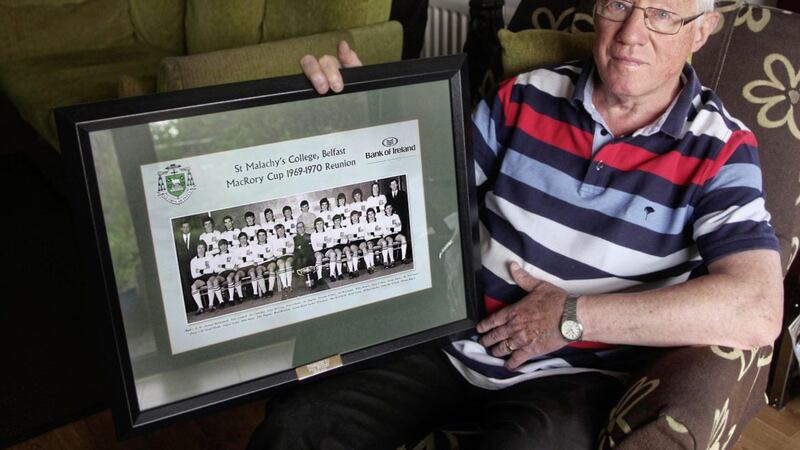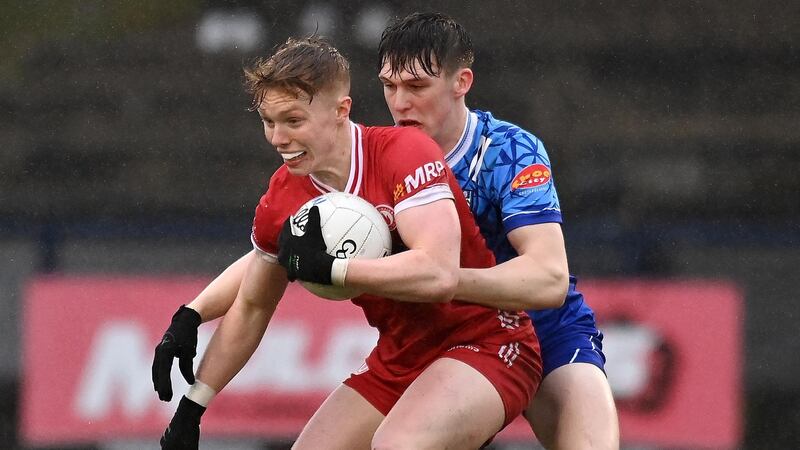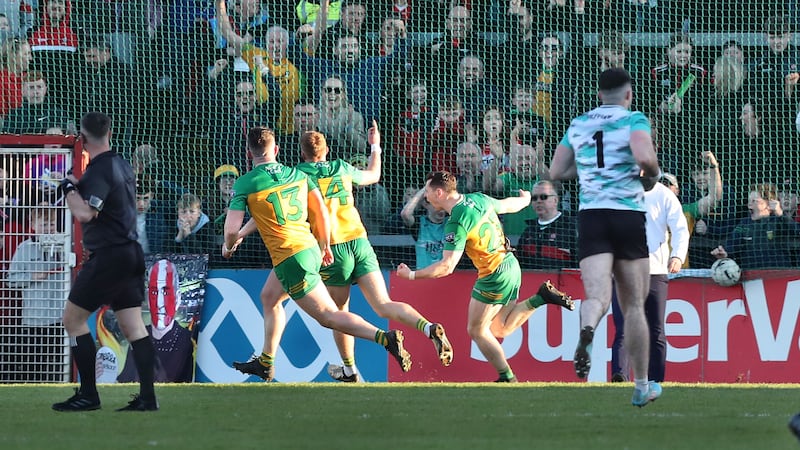“That defeat in the Hogan final was a massive disappointment and a game we should never have lost. Coláiste Chríost Rí scored a goal in the last minute – devastating. I’d put it on a par with losing the Championship with Celtic on the final day of the season in 2005.”
Martin O’Neill on losing the 1970 Hogan Cup final
* * * * * * * * * * * * * * * *
PHIL Stuart’s first teaching job was a tough station. St Peter’s Primary School, just off the back of the Falls Road, he was there for three years from 1964.
St Malachy’s came to his rescue three years later. A mile and a half away on the Antrim Road, Stuart took office in the Irish Department in 1967.
His coaching career effectively began the moment he stepped through the doors. The school’s head of PE, Mick McCormick collared him instantly to take the Rannafast team.
“I took it and one day the boys came to me and said ‘Mr Stuart, there’s a new boy playing soccer in the alley, and he’s brilliant’. I asked his name and they said ‘Martin O’Neill’. I said ‘get him out on that pitch immediately’.
Phil was long-time friends with Martin O’Neill’s brothers Gerry and Leo, both of whom played with him for Derry, and their younger sibling used to tag along when the pair would come up to Ballinderry and stay in the bar with the Stuarts.
There the future European Cup winner with Nottingham Forest, and now Republic of Ireland manager, dazzled them with his skills.
“This was the wee fella that used to play keep-ball when Gerry and Leo brought him down to visit at the pub in Ballinderry.”
He didn’t know when he took the job in St Malachy’s that he would cross paths with a talent that would guide the school to their second MacRory Cup success, some 45 years after the first.
They won the 1968/69 Rannafast and although the team was a year young, they entered the MacRory.
With the O’Neill brothers, John and Pat Maginn, Basil McClean, Kevin Young, Eugene Grant and Donal Meade among them, it was evidently a special team.
“That team just came from heaven,” said Grant at a ceremony in Stormont years later to remember St Malachy’s success.
Bishop Donal McKeown had joined the school’s Diocesan Seminary in 1968 and in the programme produced for the team’s reunion in 2001, he recalled being asked to play on a team of “big university students” that would give them a game.
Gerry O’Neill was teaching in St Colman’s Newry and taking their team when the schools crossed paths twice along the way; once in the league stage and then in a tight semi-final. It was the younger sibling on the field who would win out on both days.
He would go up against another old friend in the final, Mick Brewster on the line for St Michael’s Enniskillen, who had lost the previous two finals.
Despite one of the 12 buses carrying supporters to Coalisland catching fire on the way – no one was hurt – the Antrim Road school ploughed on and won by 2-6 to 0-6, the goals coming from Kevin Young and poacher-in-chief Owen Roe O’Neill.
“Hardly any of them went on to county standard. They were just a wonderfully coherent team. They played very well together,” says Stuart of that team.
The Hogan Cup campaign that followed brought them to within seconds of unchartered land that they’ve never been close to since.
They were too good for St Colman’s Claremorris in the semi-final, producing a display that prompted Cavan legend Mick Higgins to enter the Breffni Park bowels after the game and pay tribute.
“I went out to see him and brought him into the boys, he congratulated them and said ‘boys, that game of football you played was the best ever display I’ve seen since the opening of Breffni Park’,” recalls Stuart.
That was a particularly touching moment for the Ballinderry because unbeknown to Higgins, Stuart used to get his neighbour Mrs Rocks to keep The Irish Press for him so he could cut out pictures of his Breffni hero.
The final was in Croke Park against Cork city outfit Colaiste Chriost Rí, and was played before a National League semi-final between Derry and Mayo on April 19, 1970.
St Malachy’s led all the way until the depths of injury-time when Martin O’Neill had the ball in his possession.
It was the one man they’d have wanted on it. He spotted his brother Owen Roe making a run in behind the Chriost Rí defence and tried to split them with the pass.
The Chriost Rí defence cut it out and hit on the break. Martin O’Doherty crossed and the St Malachy’s defence hesitated enough to allow Noel Miller to slip in and side-foot the ball into the net.
The final whistle went on the kickout. Chriost Rí had been in the lead for all of 20 seconds in the entire game, but it’s their name that was inscribed on the trophy at the end of it.
When they returned in September they endeavoured to retain their MacRory title. They knew they’d be without Basil McClean, Eugene Grant, Donal Meade, Pat Cumiskey and Willie Hunter, who had all moved on to third level education.
What Phil Stuart didn’t bargain for was the ignominious way in which it would all end.
Having again beaten St Michael’s, they were paired with cross-city rivals St Mary’s CBS in the semi-final. The game was due to be played at Casement Park until Antrim county board vetoed it.
They weren’t prepared to let the young Martin O’Neill play on GAA territory because he had signed for Distillery FC, citing the old Rule 27, despite an unwritten code that it didn’t apply to schoolboy football.
Antrim officialdom stood their ground and in the end, both schools had to trail out of Belfast and go to Omagh. St Mary’s were victorious and went on to take the extra step and win the Hogan Cup on top of the MacRory.
That was to be Phil Stuart’s last game as manager of a MacRory team at the school. He stepped down and left the college in 1975 to take up a post as a lecturer at St Mary’s University, where he stayed until he retired in 1997.
* * * * * * * * * * * * * * * *
NOW 80, Phil Stuart retains the broad shoulders and upright stance of a man strengthened, not harboured, by a career in Gaelic football.
It’s often remarked that his midfield partner from Derry’s run to the All-Ireland final of 1958 and lifelong friend Jim McKeever could still play yet, such is the freshness of his lithe frame and the sharpness of his mind.
Stuart is not far behind. As he sits at one side of the kitchen table in the homely surroundings that he and Lila have spent their 53 married years in, two framed images at his back bear great memories.
The top one contains the final score from the replay of 1958 Sigerson Cup final: Queen’s University 0-11 UCD 0-10.
The bottom one is almost identical and holds the squad names and scoreline from the 1964 final, where Queen’s claimed their second title.
Phil Stuart was at midfield for the first and along the line with the late, great Paddy O’Hara for the second.
In his playing years, they were underdogs every year. The Sigerson at that time contained just four teams, one from each province, and in 1958 it was played in Galway.
At half-time, there was an air of the same old story. UCD 2-6 Queen’s 0-1, the scoreboard read.
“Paddy O’Hara was inspirational at half-time, he told us we were northerners; that we must stand up for the north. He said ‘you can only do better, and I know you can do better’.”
Better they did. UCD scored a single point in the second half as their visitors clawed at the lead. Three points between them in injury-time, Queen’s were awarded a 45.
“Peter Smith, our left-half, was a great kicker of a dead ball. He sent it in and the great Mick Brewster had left full-back, he caught it about 21 yards out.
“He turned around and got swamped and saw me on the fringe and threw it out. I whacked it on the left foot and it went into the corner of the net like a bullet. A draw.”
UCD refused to play extra-time and it was three months before the replay took place in a halfway house at Ballybay.
“Again we froze at the start and they were leading up 0-6 to 0-0 at half-time. Paddy told us they’d lead 12-1 in the last one so we were bound to win this one.”
Win they did. The game followed a similar pattern to the drawn one and it was won by a late score from Bellaghy’s Tom Scullion, who remains Derry club football’s most successful player to this day.
Phil Stuart was at Trench House doing his post-graduate by the time of the replay and that was to be the finish of his Sigerson glory as a player, but five years later he came in alongside Paddy O’Hara to help coach the university to their second title.
* * * * * * * * * * * * * * * *
ON the whole, Croke Park wasn’t kind to him. He played in the All-Ireland final of 1958 and two National League finals in the three years that followed, and lost all three.
The Hogan Cup final was one of Phil Stuart’s two visits to the venue as a coach, both of which also ended in defeat.
Derry lost the 1987 All-Ireland semi-final to Meath under the triumvirate of Tom Scullion, Jim McKeever and Phil Stuart.
But they had won an Ulster title weeks earlier, beating Armagh in a tight decider. The experience of men like Joe Irwin and Plunkett Murphy was imbued by an influx of youth like Enda Gormley, Damian Cassidy and Dermot McNicholl – whose injury was a major part of Derry’s undoing in Croke Park.
The Monday morning headline in The Irish News simply screamed ‘Hamstrung!’ in reference to the Glenullin man’s woes. He hobbled on to the pitch for the start and his ineffectiveness over the 45 minutes he was able to manage underpinned a lack of belief from top to bottom.
“It was a triumvirate and it wasn’t a good setup because we never defined each other’s roles. Nobody knew who should stand up and say something. It was difficult to consult on the line; there were just too many cooks.
”It wasn’t a good system really and I think it got through to the players. We lost the dressing room, as they’d say nowadays.
“The Meath game was a match we should have won. Meath were not a great team,” says Stuart, echoing the post-match words of McNicholl himself, who said: “Meath won, but they aren’t a great team.”
Yet they would win back-to-back All-Irelands and it would be six years, and well beyond the reign of Scullion, McKeever and Stuart, before Derry would climb the Hogan Stand steps.
They lost their provincial title rather listlessly to Down in an Ulster quarter-final in Ballinascreen the following May, the Mourne tactic of breaking the ball off Murphy and Brian McGilligan at midfield befuddling the Oak Leafers.
The trio stood down at the end of the season, their legacy assured as a rare Ulster winning management team.
Stuart would go on to briefly coach his native Ballinderry – “I was unfortunate that it was just pre-Enda Muldoon” – and also coached Antrim for three seasons before his spell with his native county.
“I was in the training college and I knew the boys from Trench House. When they pulled on their county jersey, they played for demons for Tyrone and Derry and Armagh, but when the Antrim boys pulled on theirs, it wasn’t the same.
“They’d rather play for St John’s or St Gall’s. That was more important to them.
“The tradition of an Antrim team winning in 1947 was too far back. They had no tradition to live up to. I could get nothing going with them at all, and I don’t think I worked as hard with any team. I had to give up after three years.”
A brief spell with Sarsfields and a hand in the founding of St Teresa’s club was the height of his involvement in Antrim club football.
His playing days were almost too brief – though not so that they couldn’t incorporate a summer earning $100 per game with the Cavan club in New York.
The commitment level to travel from Belfast to Newbridge for Derry training was away ahead of its time, and the Volkswagen Beetle clocked up the miles.
But life outside football was in Belfast, and at 80 he has no regrets.
The bonds that were formed stayed, even with opponents. He and Jim McKeever travelled down to the funeral of Kevin Heffernan, who starred for that Dublin team in ’58, and received a great welcome.
The number 9 jersey he wore that day ended up back in his possession in later years after it was found in a shed in Magherafelt, left over from the set after they’d been donated to the Rossa club.
He handed it over again for the GAA’s 125th anniversary celebrations, where it appeared on display at a temporary museum set up in the city.
The cloth has outlasted a lot of the team now, but those that remain will never forget. They formed a guard of honour at the doors of St Trea’s Church, Newbridge recently at the funeral of Roddy Gribbin, who coached the ’58 team.
Friends ‘til the end.








